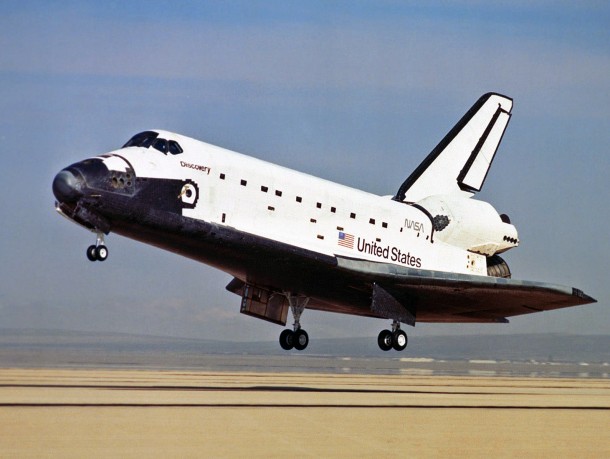
Thirty-one years ago this month, the Space Shuttle Discovery and her five man crew landed on Rogers Dry Lake at Edwards Air Force Base to successfully complete the Return-to-Flight (RTF) mission of STS-26. The flight signaled a resumption of the Space Shuttle Program after a 32-month hiatus in manned spaceflight resulting from the Challenger disaster.
Well chronicled is the tragic loss of the Space Shuttle Challenger and its crew of seven on Tuesday, 28 January 1986. Following lift-off at 16:38 UTC from Cape Canaveral’s LC-39B, the launch vehicle disintegrated 73 seconds into flight. The presidentially-appointed Rogers Commission concluded that the primary cause was failure of an O-ring seal in a field joint of the right Solid Rocket Booster (SRB).
While the SRB O-ring failure was the physical cause of the Challenger mishap, the Rogers Commission brought to light a more fundamental and disturbing reason for the tragedy. Specifically, the very decision to launch Challenger on that unusually cold January morning in Florida was fundamentally flawed.
As masterfully delineated in Dianne Vaughan’s “The Challenger Launch Decision”, a culture of deviance with respect to Shuttle flight safety issues had slowly developed at NASA. Pressure to launch, scarce resources and organizational disconnects contributed to NASA management’s blind spot when it came to Shuttle flight safety. The SRB contractor was culpable as well and for the same reasons.
Following redesign and testing of the SRB field joints and the implementation of a myriad of other fixes, NASA prepared to return the Shuttle to flight. The mission was designated as STS-26. To the Space Shuttle Discovery would go the honor of and the responsibility for flying the RTF mission. STS-26 was to be a five day orbital mission.
A five-member crew was selected by NASA to fly STS-26. Each crew member had spaceflight experience. You remember their names. Mission Commander Frederick H. “Rick” Hauck, Pilot Richard O. Covey, and Mission Specialists John M. “Mike” Lounge, George D. “Pinky” Nelson and David C. Hilmers.
Discovery and her brave crew lifted-off from at 15:37 UTC on Thursday, 29 September 1988 from the very same location that Challenger did; LC-39B at Cape Canaveral, Florida. Millions watched that day. Some were in the big crowds that formed in and around the Cape complex. Most observed the event on television. Many prayed.
All who watched Discovery lift-off that day could not forget the previous Shuttle flight. Indeed, they remembered what happened just after the CAPCOM’s call: “Challenger, go at throttle-up.” (Ironically, Richard Covey was the CAPCOM who made that very call.) Today, they heard a similar call over the Shuttle communications network: “Discovery, go at throttle-up.” A collective breath was held. After throttle-up, Discovery continued all the way to orbit. YES!!!
In comparison with the launch, initial climbout, and ascent into space, the remainder of the mission seemed somewhat anti-climatic. A Tracking and Data Relay Satellite (TDRS) was deployed from Discovery’spayload bay to replace the one lost in the Challenger explosion. A multitude of space experiments was conducted by the crew. Fairly standard stuff. Only deboost, the rigors of reentry and the typical dead-stick landing lay ahead.
Discovery landed on Runway 17 at Edwards Air Force Base on Monday, 03 October 1988. Main gear touchdown occurred at 16:37 UTC. Approximately, 450,000 American’s witnessed Discovery’s landing in person. A few who did had witnessed its launch in person as well.
The emotion that attended Discovery’s landing in October 1988 was simply overwhelming. Indeed, the experience was an integral part of the healing process for a nation that still grieved the loss of Challenger and her crew. A TIME magazine cover page headline the following week excitedly read: “Whew! America Returns to Space” And indeed it had.
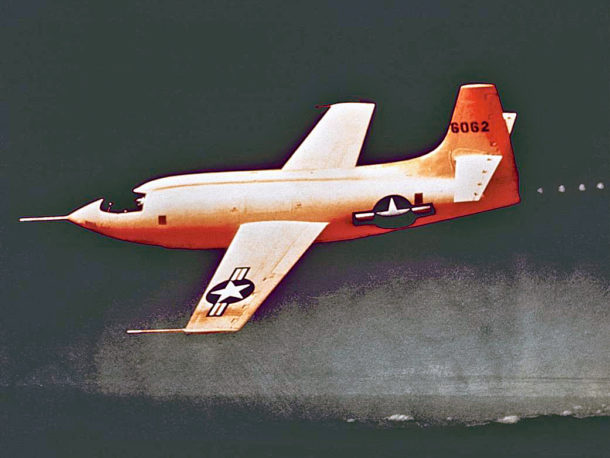
Seventy-two years ago today, the rocket-powered USAF/Bell XS-1 experimental aircraft exceeded the speed of sound when it reached a maximum speed of 700 mph (Mach 1.06) at 45,000 feet.
Bell Aircraft Corporation of Buffalo, New York built three copies of the XS-1 under contract to the United States Army Air Forces (USAAF). The aircraft were designed to approach and then fly beyond the speed of sound.
The Bell XS-1 was 31-feet in length and had a wing span of 28 feet. Gross take-off weight was around 12,500 lbs. The aircraft had an empty weight of about 7,000 lbs. Propulsion was provided by a Reaction Motors XLR-11 rocket motor capable of generating a maximum thrust of 6,000 lbs.
On the morning of Tuesday, 14 October 1947, the XS-1 (S/N 46-062) dropped away from its B-29 mothership (S/N 45-21800) as the pair flew at 220 mph and 20,000 feet. In the XS-1 cockpit was USAAF Captain and World War II ace Charles E. Yeager. The young test pilot had named the aircraft Glamorous Glennis in honor of his wife.
Following drop, Yeager sequentially-lit all four XLR-11 rocket chambers during a climb and push-over that ultimately brought him to level flight around 45,000 feet. The resulting acceleration profile propelled the XS-1 slightly beyond Mach 1 for about 20 seconds. Yeager then shutdown the rocket, decelerated to subsonic speeds, and landed the XS-1 on Muroc Dry Lake at Muroc Army Airfield, California.
The world would not find out about the daring exploits of 14 October 1947 until December of the same year. As it was, the announcement came from a trade magazine that even today is sometimes referred to as “Aviation Leak”.
Today, Glamorous Glennis is prominently displayed in the Milestones of Flight hall of the National Air and Space Museum located in Washington, DC. For his intrepid piloting efforts in breaking the sound barrier, Chuck Yeager was a co-recipient of the 1948 Collier Trophy.
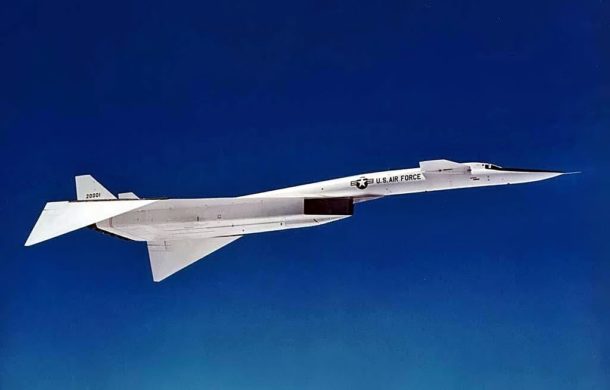
Fifty-four years ago this month, the USAF/North American XB-70A Valkyrie reached three times the speed of sound for the first time. This historic aviation achievement took place on the 18th anniversary of the breaking of the sound barrier by the USAF/Bell XS-1.
When it comes to legendary aircraft, aviation enthusiasts speak in almost reverent terms about the XB-70A Valkyrie. Indeed, few aircraft have evoked such utter awe or symbolized better the profound majesty of flight than the “The Great White Bird”. Though its flight history was brief, the XB-70A’s influence on aviation has proven to be of enduring worth.
The Valkyrie measured 185 feet in length, had a wingspan of 105 feet and an empty weight of 210,000 pounds. With a GTOW of 550,000 pounds, it was the heaviest supersonic-capable aircraft of all-time. The aircraft was powered by a six-pack of General Electric YJ93-GE-3 turbojets generating more than 172,000 pounds of thrust in afterburner.
To enhance lift-to-drag ratio and directional stability at high Mach number, the Valkyrie was configured with wing tips that could be deflected downward as much as 65 degrees. Each wing tip was the size of an USAF/Convair B-58A Hustler wing panel. To this day, the XB-70A deflectable wing tip is the largest control surface ever used on an aircraft.
The XB-70A was originally intended to be a supersonic strategic bomber. The aircraft’s mission was to penetrate Soviet airspace at Mach 3 and deliver nuclear ordnance from an altitude of 72,000 feet. However, the rapid ascendancy of Soviet surface-to-air missile capability would compromise the type’s military mission before it even flew.
As a consequence of the above, the Valkyrie ultimately became a high-speed flight research aircraft. Only two (2) copies were constructed and flown. Ship No. 1 (S/N 62-0001) made its maiden flight on Monday, 21 September 1964 while Ship No. 2 (62-0207) first took to the air on Saturday, 17 July 1965.
XB-70A Ship No. 1 became the first Valkyrie to reach Mach 3. It did so while flying at an altitude of 70,000 feet on Thursday, 14 October 1965. The flight crew consisted of North American Aviation test pilot Alvin S. White (aircraft commander) and USAF Colonel Joseph Cotton (co-pilot).
The XB-70A aircraft flew all of their flight research missions out of Edwards Air Force Base in California. Between September of 1964 and February of 1969, a total of 129 XB-70A research flights took places; 83 by Ship No. 1 and 46 by Ship No. 2. A total of nearly 253 flight hours was amassed by the aircraft.
The XB-70A Program made significant contributions to high-speed aircraft technology including aerodynamics, aerodynamic heating, flight controls, structures, materials, and air-breathing propulsion. Lessons-learned from its flight research have been applied to numerous aircraft developments including the B-1A, American SST, Concorde and the TU-144.
XB-70A Ship No. 1 survived the flight test program while Ship No. 2 did not. The latter was destroyed in a mid-air collision with a NASA F-104N on Wednesday, 08 June 1966. Today, XB-70A Ship No. 1 can be seen at the National Museum of the United States Air Force at Wright-Patterson Air Force Base in Dayton, Ohio.
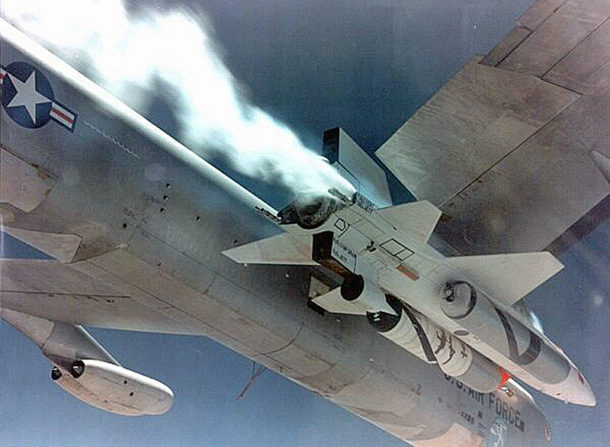
Fifty-two years ago today, USAF Major William J. “Pete” Knight piloted the fabled USAF/North American X-15A-2 rocket-powered hypersonic flight research aircraft to a record speed of 4,520 mph – roughly a mile and a quarter per second. This mark is approximately 50 percent faster than the highest speed ever attained by a “speeding bullet”.
North American’s original X-15 production run consisted of three (3) aircraft. The X-15A-2 was a rebuild of the 2nd airframe (S/N 56-6671) which had been severely damaged during an emergency landing at Mud Lake, Nevada in November of 1962.
The rebuilt aircraft was configured with a pair of propellant-containing drop tanks that allowed the type’s XLR-99 rocket engine to operate 60 seconds beyond the stock X-15’s 80-second burn time. Among other modifications, the aircraft also carried a pylon-mounted dummy ramjet in the ventral region of the aft fuselage.
With the addition of the external propellant tanks, the X-15A-2 was really a three-stage vehicle. The first stage was the NASA NB-52B mothership which launched the X-15 at Mach 0.82 and 45,000 feet. The second stage consisted of the propellant-laden external tanks which were jettisoned at Mach 2.0 and 70,000 feet. The third stage was the X-15A-2 with its entire internal propellant load.
Due to the increased speed of the X-15A-2, the aircraft was covered with Martin MA-25S ablator to protect it from the higher aerodynamic heating loads. The baseline ablator was pink in color and gave the X-15A-2 a rather odd appearance. Fortunately, application of a white wear/sealer over the ablator gave the aircraft a more dignified look.
On Tuesday, 03 October 1967, Pete Knight and the X-15A-2 dropped away from the NB-52B (S/N 52-008) at the start of the X-15 Program’s 188th mission. Knight ignited the XLR-99 rocket engine and executed a pull-up followed by a pushover to level flight at a little over 102,000 feet. Aircraft speed at XLR-99 burnout was 4,520 mph (Mach 6.7).
As the aircraft decelerated following burnout, Knight executed a series of pre-planned flight maneuvers to acquire vital aerodynamics data. However, passing through Mach 5.5, he received an indication in the cockpit that a high temperature condition existed in the XLR-99 engine bay.
Knight attempted to jettison the aircraft’s remaining propellants, but to no avail. The jettison tubes were welded shut by whatever was happening in the engine bay. This meant he would land heavier and faster than usual. Fortunately, Knight’s piloting skills allowed him to get the X-15A-2 on to Rogers Dry Lake in one piece.
As flight support personnel inspected the X-15A-2 airframe following Knight’s emergency landing, they were alarmed at what they found. The aft ventral region of the aircraft had incurred significant thermal damage. Further, the dummy ramjet was gone.
As reported in the classic NASA document, TM-X-1669, higher-than-expected aerodynamic heating levels were responsible for the damage to the X-15A-2.
First, shock wave/boundary layer interaction heating on the lower fuselage just ahead of the pylon (1) completely destroyed the ablator in that region and (2) penetrated the Inconel-X airframe structure. This introduced very high temperature air into the X-15 engine bay.
Second, impingement of the dummy ramjet nose shock on the detached bow shock coming off of the pylon produced a shear layer that focused on the pylon leading edge. The resulting heating rates were of sufficient magnitude and duration to both burn away the pylon ablator and burn through the pylon structure. The weakened pylon structural attachment eventually failed and the dummy ramjet departed the main airframe.
Pete Knight will forever hold the record for the fastest X-15 flight. However, the X-15A-2 never flew again. Only 11 more flights remained in the X-15 Program at the time. A lack of time and funding meant that little was to be gained by repairing the thermally-damaged aircraft.
As for the final disposition of the X-15A-2 (S/N 56-6671), the aircraft’s remaining ablator was removed with its external surface cleaned-up and original markings restored. The aircraft now resides in a place of honor at the National Museum of the United States Air Force located at Wright-Patterson AFB in Dayton, Ohio.
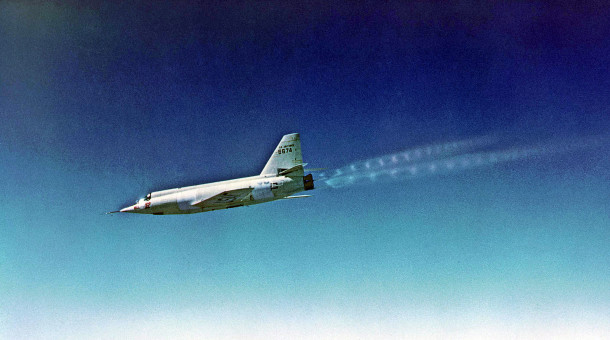
Sixty-three years ago today, the No. 1 USAF/Bell X-2 rocket-powered flight research aircraft reached a record speed of 2,094 mph with USAF Captain Milburn G. “Mel” Apt at the controls. However, triumph quickly turned to tragedy when the aircraft departed controlled flight, crashed to destruction, and Apt perished.
Mel Apt’s historic achievement came about because of the Air Force’s desire to have the X-2 reach Mach 3 before turning it over to the National Advisory Committee For Aeronautics (NACA) for further flight research testing. Just 20 days prior to Apt’s flight in the X-2, USAF Captain Iven C. Kincheloe, Jr. had flown the aircraft to a record altitude of 126,200 feet.
On Thursday, 27 September 1956, Apt and the X-2 (Ship No. 1, S/N 46-674) dropped away from the USAF B-50 mothership at 30,000 feet and 225 mph. Despite the fact that Mel Apt had never flown an X-aircraft, he executed the flight profile exactly as briefed. In addition, the X-2′s twin-chamber XLR-25 rocket motor burned propellant 12.5 seconds longer than planned. Both of these factors contributed to the aircraft attaining a speed in excess of 2,000 mph.
Apt and his aerial steed hit a peak Mach number of 3.2 at an altitude of 65,000 feet. Based on previous flight tests as well as flight simulator sessions, Apt knew that the X-2 had to slow to roughly Mach 2.4 before turning the aircraft back to Edwards. This was due to degraded directional stability, control reversal, and aerodynamic coupling issues that adversely affected the X-2 at higher Mach numbers.
However, Mel Apt was now faced with a difficult decision. If he waited for the X-2 to slow to Mach 2.4 before initiating a turn back to Edwards Air Force Base, he quite likely would not have enough energy and therefore range to reach Rogers Dry Lake. On the other hand, if he decided to initiate the turn back to Edwards at high Mach number, he risked having the X-2 depart controlled flight. Flying in a coffin corner of the X-2’s flight envelope, Apt opted for the latter.
As Apt increased the aircraft’s angle-of-attack, the X-2 departed controlled flight and subjected him to a brutal pounding. Aircraft lateral acceleration varied between +6 and -6 g’s. The battered pilot ultimately found himself in a subsonic, inverted spin at 40,000 feet. At this point, Apt effected pyrotechnic separation of the X-2′s forebody which contained the cockpit and a drogue parachute.
X-2 forebody separation was clean and the drogue parachute deployed properly. However, Apt still needed to bail out of the descending unit and deploy his personal parachute to complete the emergency egress process. However, such was not to be. Mel Apt ran out of time, altitude, and luck. The young pilot lost his life when the X-2 forebody from which he was trying to escape impacted the ground at a speed of one hundred and twenty miles an hour.
Mel Apt’s flight to Mach 3.2 established a record that stood until the X-15 exceeded that mark in August 1960. However, the price for doing so was very high. The USAF lost a brave test pilot and the lone remaining X-2 on that fateful day in September 1956. The mishap also ended the USAF X-2 Program. NACA never did conduct flight research with the X-2.
However, for a few terrifying moments, Mel Apt was the fastest man alive.
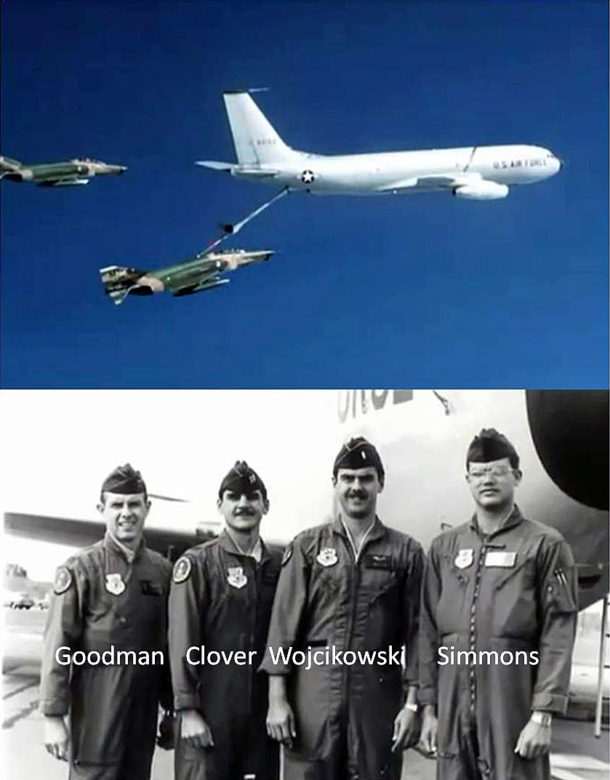
Thirty-six years ago this month, the valiant crew of a USAF KC-135 Stratotanker performed multiple aerial refuelings of a stricken USAF F-4E Phantom II over the North Atlantic Ocean. Conducted under extremely perilous flight conditions, the remarkable actions of the aerial tanker’s crew allowed the F-4E to remain aloft long enough to safely divert to an alternate landing field.
On Monday, 05 September 1983, a pair of USAF F-4E Phantom II fighter-bombers departed the United States for a routine flight to Germany. To negotiate the trans-atlantic distance, the F-4E’s would require aerial refueling. As they approached the refueling rendezvous point, one of the aircraft developed trouble with its No. 2 engine. Though still operative, the engine experienced a significant loss of thrust.
The problem with the Phantom’s engine caused it to lose speed and altitude. Further, its No. 1 engine began to overheat as it tried to keep the aircraft airborne. As if this were not enough, the aircraft’s starboard hydraulic system became inoperative. Coupled with the fact that the fuel gauge was edging toward empty, the specter of an ejection and parachute landing in the cold Atlantic looked all but certain for the F-4E crew.
Enter the venerable KC-135 Stratotanker and her crew of Captain Robert J. Goodman, Captain Michael R. Clover, 1st Lt Karol R. Wojcikowski and SSgt Douglas D. Simmons. Based with the 42nd Aerial Refueling Squadron, their immediate problem was two-fold. First, locate and navigate to the pair of F-4E aircraft flying somewhere over the open ocean. Second, get enough fuel to both aircraft so the latter could complete their trans-atlantic hop. Time was of the essence.
Following execution of the rendezvous, the KC-135 crew needed to get their steed out in front of the fuel-hungry Phantoms. The properly operating Phantom quickly took on a load of fuel. However, the stricken aircraft continued to lose altitude as its pilot struggled just to keep the aircraft in the air. By the time the first hook-up occurred, both the F-4E and KC-135 were flying below an altitude of 7,000 feet.
Whereas normal refueling airspeed is 315 knots, the refueling operation between the KC-135 and F-4E occurred below 200 knots. Both aircraft had to fly at high angle-of-attack to generate sufficient lift at this low airspeed. Boom Operator Simmons was faced with a particularly difficult challenge in that the failed starboard hydraulics of the F-4E caused it to yaw to the right. Nonetheless, he was able to make the hook-up with the F-4E refueling recepticle and transfer a bit of fuel to the ailing aircraft.
The transfer of fuel ceased during the first aerial refueling when the mechanical limits of the aircraft-to-aircraft connection were exceeded. The F-4E started to dive as it came off the refueling boom. At this critical juncture, Captain Goodman made the decision to follow the Phantom and get down in front of it for another go at aerial refueling. As the second fuel transfer operation began, the airspeed indicator registered 190 knots; barely above the KC-135’s landing speed.
While additional fuel was transferred to the F-4E, it was still not enough for it to make the divert airfield at Gander, New Foundland. The KC-135 performed two more risky aerial refuelings of the struggling Phantom. The last of which occurred at an altitude of only 1,600 feet above the ocean. At times during these harrowing operations, the KC-135 actually towed the F-4E on its refueling boom to help the latter gain altitude.
At length, the F-4E manged to climb to 6,000 feet and maintain 220 knots as its No. 1 engine began to cool. Able to fend for itself once again, the Phantom punched-off the KC-135 refueling boom. Goodman and crew continued to escort the F-4E to the now-close landing field at Gander, New Foundland. The Phantom pilot greased the landing much to the relief and joy of all.
For their heroic efforts on that eventful September day over the North Atlantic, the crew of the KC-135 received the USAF’s Mackay Trophy for the most meritorious flight of 1983.
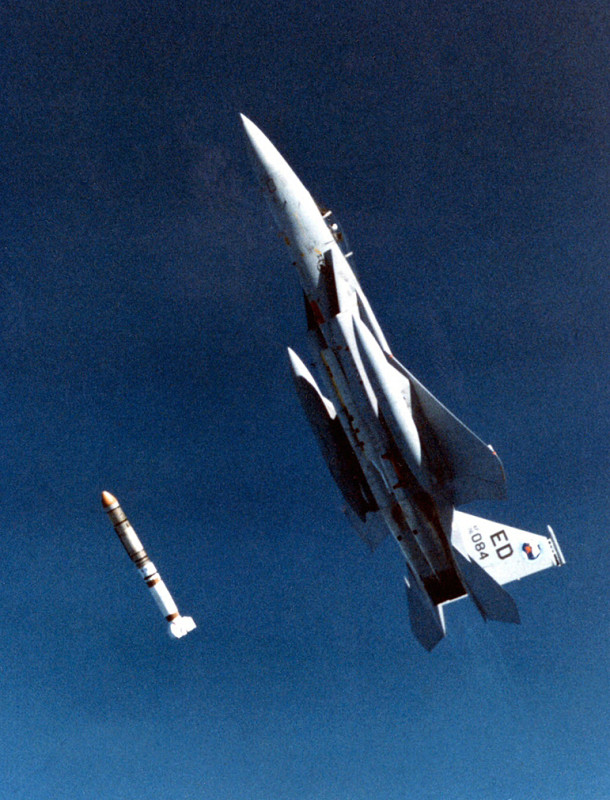
Thirty-four years ago today, the USAF/LTV ASM-135 anti-satellite missile successfully intercepted a target satellite orbiting 300 nautical miles above surface of the Earth. The historic test was the first and only time that an aircraft-launched missile successfully engaged and destroyed an orbiting spacecraft.
The United States began testing anti-satellite missiles in the late 1950′s. These and subsequent vehicles used nuclear warheads to destroy orbiting satellites. A serious disadvantage of this approach was that a nuclear detonation intended to destroy an adversary satellite will likely damage nearby friendly satellites as well.
By the mid 1970′s, the favored anti-satellite (ASAT) approach had changed from nuclear detonation to kinetic kill. This latter approach required the interceptor to directly hit the target. The 15,000-mph closing velocity provided enough kinetic energy to totally destroy the target. Thus, no warhead was required.
The decision to proceed with development and deployment of an American kinetic kill weapon was made by President Jimmy Carter in 1978. Carter’s decision came in the aftermath of the Soviet Union’s successful demonstration of an orbital anti-satellite system.
LTV Aerospace was awarded a contract in 1979 to develop the Air-Launched Miniature Vehicle (ALMV) for the USAF. The resulting anti-satellite missile (ASM) system was designated the ASM-135. The two-stage missile was to be air-launched by a USAF F-15A Eagle executing a zoom climb. In essence, the aircraft acted as the first stage of what was effectively a 3-stage vehicle.
The ASM-135 was 18-feet in length and 20-inches diameter. The 2,600-lb vehicle was launched from the centerline station of the host aircraft. The ASM consisted of a Boeing SRAM first stage and an LTV Altair 3 second stage. The vehicle’s payload was a 30-lb kinetic kill weapon known as the Miniature Homing Vehicle (MHV).
The ASM-135 was first tested in flight on Saturday, 21 January 1984. While successful, the missile did not carry a MHV. On Tuesday, 13 November 1984, a second ASM-135 test took place. Unfortunately, the missile failed when the MHV that it was carrying was aimed at a star that served as a virtual target. Engineers went to work to make the needed fixes.
In August of 1985, a decision was made by President Ronald Reagan to launch the next ASM-135 missile against an orbiting US satellite. The Solwind P78-1 satellite would serve as the target. Congress was subsequently notified by the Executive Branch regarding the intended mission.
The historic satellite takedown mission occurred on Friday, 13 September 1985. USAF F-15A (S/N 77-0084), stationed at Edwards Air Force Base, California and code-named Celestial Eagle, departed nearby Vandenberg Air Force Base carrying the ASM-135 test package. Major Wilbert D. Pearson was at the controls of the Celestial Eagle.
Flying over the Pacific Ocean at Mach 1.22, Pearson executed a 3.8-g pull to achieve a 65-degree inertial pitch angle in a zoom climb. As the aircraft passed through 38,000-feet at Mach 0.93, the ASM-135 was launched at a position 200 miles west of Vandenberg. Both stages fired properly and the MHV intercepted the Solwind P78-1 satellite within 6-inches of the aim point. The 2,000-lb satellite was completely obliterated.
In the aftermath of the stunningly successful takedown of the Solwind P78-1 satellite, USAF was primed to continue testing the ASM-135 and then introduce it into the inventory. Plans called for upwards of 112 ASM-135 rounds to be flown on F-15A aircraft stationed at McChord AFB in Washington state and Langley AFB in Virginia. However, such was not to be.
Even before the vehicle flew, the United States Congress acted to increasingly restrict the ASM-135 effort. A ban on using the ASM-135 against a space target was put into effect in December 1985. Although USAF actually conducted successful additional ASM-135 flight tests against celestial virtual targets in 1986, the death knell for the program had been sounded.
In the final analysis, a combination of US-Soviet treaty concerns, tepid USAF support, and escalating costs killed the ASM-135 anti-satellite effort. The Reagan Administration formally cancelled the program in 1988.
While the ASM-135 effort was relatively short-lived, the technology that it spawned has propagated to similar applications. Indeed, today’s premier exoatmospheric hit-to-kill interceptor, the United States Navy SM-3 Block IA anti-ballistic missile, is a beneficiary of ASM-135 homing guidance, intercept trajectory and kinetic kill weapon technologies.
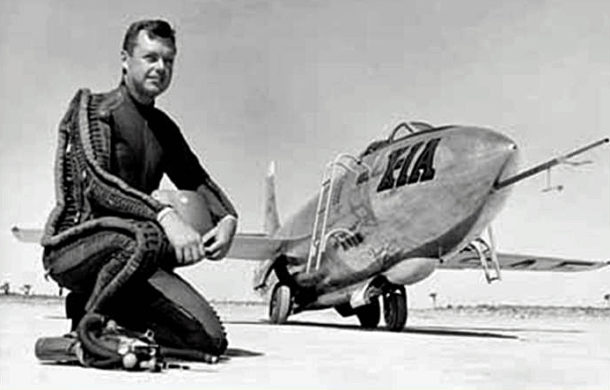
Sixty-five years ago this month, USAF Major Arthur W. “Kit” Murray set a new world altitude record of 90,440 feet in the rocket-powered Bell X-1A. In doing so, Murray reported that he could detect the curvature of the Earth from the apex of his trajectory.
The USAF/Bell X-1A was designed to explore flight beyond Mach 2. The craft measured 35.5 feet in length and had a wing span of 28 feet. Gross take-off weight was 16,500 pounds. Power was provided by an XLR-11 rocket motor which produced a maximum sea level thrust of 6,000 lbs. This power plant burned 9,200 pounds of propellants (alcohol and liquid oxygen) in about 270 seconds of operation.
Similar to other early rocket-powered X-aircraft such as the Bell XS-1, Douglas D-558-II, Bell X-2 and North American X-15, the X-1A flew two basic types of high performance missions. That is, the bulk of the vehicle’s propulsive energy was directed either in the horizontal or in the vertical. The former was known as the speed mission while the latter was called the altitude mission.
On Saturday, 12 December 1953, USAF Major Charles E. “Chuck” Yeager flew the X-1A (S/N 48-1384) to an unofficial speed record of 1,650 mph (Mach 2.44). Moments after doing so, the X-1A went divergent in all three axes. The aircraft tumbled and gyrated through the sky. Control inputs had no effect. Yeager was in serious trouble. He could not control his aircraft and punching-out was not an option. The X-1A had no ejection seat.
Chuck Yeager took a tremendous physical and emotional beating for more than 70 seconds as the X-1A wildly tumbled. His helmet hit the canopy and cracked it. He struck the control column so hard that it was physically bent. His frantic air-to-ground communications were distinctly those of a man who was convinced that he was about to die.
As the X-1A tumbled, it decelerated and lost altitude. At 33,000 feet, a battered and groggy Yeager found himself in an inverted spin. The aircraft suddenly fell into a normal spin from which Yeager recovered at 25,000 feet over the Tehachapi Mountains situated northwest of Edwards. Somehow, Yeager managed to get himself and the X-1A back home intact.
The culprit in Yeager’s wide ride was the then little-known phenomenon identified as roll inertial coupling. That is, inertial moments produced by gyroscopic and centripetal accelerations overwhelmed aerodynamic control moments and thus caused the aircraft to depart controlled flight. Roll rate was the critical mechanism since it coupled pitch and yaw motion.
In the aftermath of Yeager’s near-death experience in the X-1A, the Air Force ceased flying speed missions with the aircraft. Instead, a series of flights followed in which the goal was to extract maximum altitude performance from the aircraft. USAF Major Arthur W. “Kit” Murray was assigned as the Project Pilot for these missions.
On Thursday, 26 August 1954, Kit Murray took the X-1A (S/N 48-1384) to a maximum altitude of 90,440 feet. This was new FAI record. Murray also ran into the same roll inertial coupling phenomena as Yeager. However, his experience was less traumatic than was Yeager’s. This was partly due to the fact that Murray had the benefit of learning from Yeager’s flight. This allowed him to both anticipate and know how to correct for this flight disturbance.
Murray’s achievement in the X-1A meant that the X-1A held the records for both maximum speed and altitude for manned aircraft. It did so until both records were eclipsed by the Bell X-2 in September of 1956.
Kit Murray was a highly accomplished test pilot who never received the public adulation and notoreity that Chuck Yeager did. He retired from the Air Force in 1960 after serving for 20 years in the military. Murray went on to a very successful career in engineering following his military service. Kit Murray lived to the age of 92 and passed from this earthly scene on Monday, 25 July 2011.
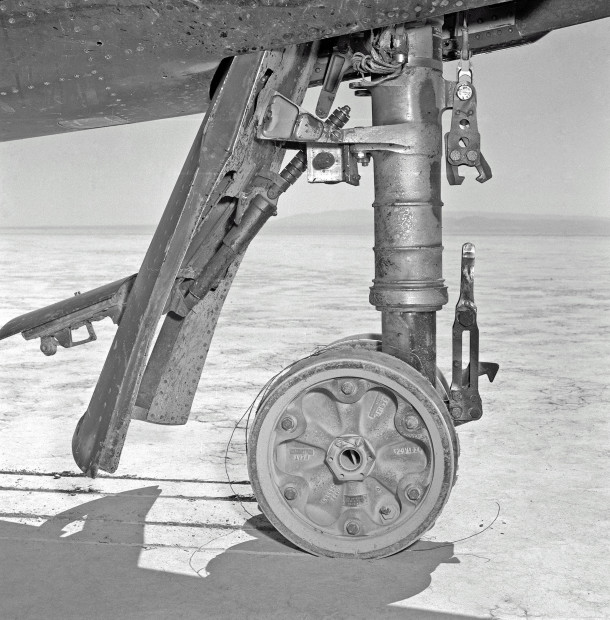
Fifty-five years ago this month, the fabled North American X-15 hit a speed of 3,590 mph (Mach 5.23) in a flight that reached an altitude of 103,300 feet. While decelerating through Mach 4.2, the nose gear of the aircraft unexpectedly deployed in flight.
The 114th powered flight of the legendary X-15 Program took place on Friday, 14 August 1964. USAF Major Robert A. Rushworth was at the controls of X-15 Ship No. 2 (S/N 56-6671). The mission would be Rushworth’s 22nd flight in the famed hypersonic aircraft.
X-15 drop from the NB-52A (S/N 52-0003) launch aircraft took place over Delamar Dry Lake, Nevada. Seconds later, Rushworth called for 100% power from the X-15’s XLR-99 liquid-fueled rocket engine as he pulled into a steep climb. He subsequently pushed-over and then leveled-off at 103,300 feet.
XLR-99 burnout occurred 80.3 seconds after ignition. At this juncture, the X-15 was traveling at 3,590 mph; better than 5 times the speed of sound. Following rocket motor burnout, the aircraft slowed and began to lose altitude under the influence of weight and aerodynamic drag.
As the Mach meter needle passed through Mach 4.2, Rushworth heard a loud bang from the airframe. The aircraft became hard to control as it gyrated in pitch, yaw and roll. Rushworth was equal to the moment and brought his troubled steed under control. However, the aircraft had an uncommanded sideslip and Rushworth had to use left aileron to hold the wings level.
Gathering his wits, Rushworth realized that the loud bang he heard was very similar to that which occurred when the nose gear was deployed in the landing pattern. Unaccountably, the X-15 nose gear had deployed in supersonic flight. An unsettling confirmation of Rushworth’s hypothesis came when the pilot spotted smoke, quite a bit of it, in the X-15 cockpit.
As Rushworth neared Edwards Air Force Base, chase aircraft caught up with him and confirmed that the nose gear was indeed down and locked. Further, the tires were so scorched from aerodynamic heating that they probably would disintegrate during touchdown on Rogers Dry Lake. They verily did.
Despite his tireless nose gear, Rushworth was able to control the rollout of his aircraft fairly well on the playa silt. He brought the X-15 to a stop and deplaned. Man and machine had survived to fly another day.
Post-flight analysis revealed that expansion of the X-15 fuselage due to aerodynamic heating was greater than expected. The nose gear door bowed or deformed outward more than anticipated as well. Together, these two anomalies caused the gear uplock hook to bend and release the nose gear. Fixes were subsequently made to Ship No. 2 to prevent a recurrence of the nose gear door deployment anomaly.
Rushworth next flew X-15 Ship No. 2 on Tuesday, 29 September 1964. He reached a maximum speed of 3,542 mph (Mach 5.2) at 97,800 feet. The nose gear door remained locked. However, while decelerating through Mach 4.5, Rushworth heard a bang that was less intense than the previous flight. This time, thermal stresses caused the nose gear door air scoop to deploy in flight. While the aircraft handled poorly, Rushworth managed to get it and himself back on the ground in one piece.
Following another redesign effort, Rushworth took to the air in X-15 Ship No. 2 on Thursday, 17 February 1965. He hit 3,539 mph (Mach 5.27) at 95,100 feet. On this occasion, both the nose gear door and nose gear door scoop remained in place. Unfortunately, the right main landing skid deployed at Mach 4.3 and 85,000 feet.
Thermal stresses were once again the culprit. Despite degraded handling qualities with the landing skid deployed, the valiant Rushworth safely landed the X-15. Upon deplaning, he is reported to have kicked the aircraft in a show of disgust and frustration. Unprofessional maybe, but certainly understandable.
Yet another redesign effort followed in the aftermath of the unexpected main landing skid deployment. This was the third consecutive mission for X-15 Ship No. 2 and Rushworth to experience a thermally-induced landing gear or landing skid deployment anomaly. Happily, subsequent flights of the subject aircraft were free of such vexing problems.
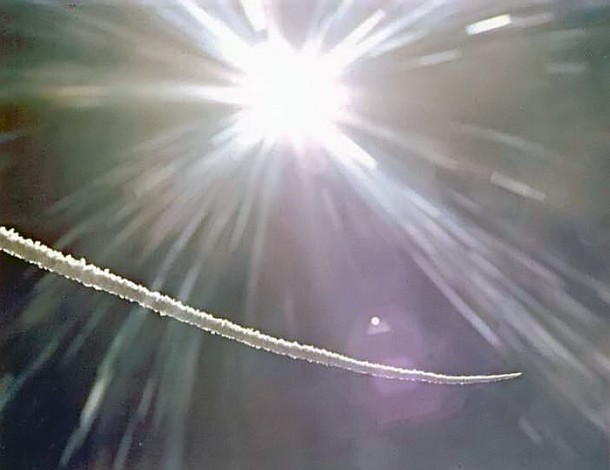
Fifty-six years ago today, NASA chief research pilot Joseph A. Walker flew X-15 Ship No. 3 (S/N 56-6672) to an altitude of 354,200 feet. This flight would mark the highest altitude ever achieved by the famed hypersonic research vehicle.
Carried aloft by NASA’s NB-52A (S/N 52-0003) mothership, Walker’s X-15 was launched over Smith Ranch Dry Lake, Nevada at 17:05:42 UTC. Following drop at around 45,000 feet and Mach 0.82, Walker ignited the X-15’s small, but mighty XLR-99 rocket engine and pulled his ship into a steep vertical climb.
The XLR-99 was run at 100 percent power for 85.8 seconds with burnout occurring around 176,000 feet on the way uphill. Maximum velocity achieved was 3,794 miles per hour which translates to Mach 5.58 at the burnout altitude. Following burnout of the XLR-99, Walker’s X-15 gained an additional 178,200 feet in altitude as it coasted to apogee.
Joe Walker went over the top at 354,200 feet (67 miles). Although he did not have much time for sight-seeing, the Earth’s curvature was strikingly obvious to the pilot as he started downhill from his lofty perch. Walker subsequently endured a hefty 5-g’s of eyeballs-in normal acceleration during the backside dive pull-out. The aircraft was brought to a wings-level attitude at 70,000 feet. Shortly after, Walker greased the landing on Rogers Dry Lake at Edwards Air Force Base, California.
The X-15 maximum altitude flight, in which the aircraft’s design altitude was exceeded by more than 100,000 feet, lasted 11 minutes and 8 seconds from drop to nose wheel stop. In that time, Walker and X-15 Ship 3 covered 305 miles in ground range. This mission was Ship No. 3’s 22nd flight and the 91st of the legendary X-15 Flight Research Program.
For Joseph Albert Walker, the 22nd of August 1963 marked his 25th and last flight in an X-15 cockpit. The mission qualified him for Astronaut Wings since he had exceeded the 328,000 foot (100 km) FAI/NASA standard set for such a distinction. However, it would be more than four decades after his historic mission that Walker would be officially be recognized as an astronaut. In a special ceremony conducted at NASA’s Dryden Flight Research Center on Tuesday, 23 August 2005, Joe Walker was posthumously awarded his Astronaut Wings.










